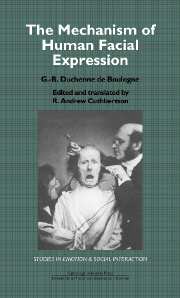Preface
Published online by Cambridge University Press: 10 November 2010
Summary
“When the spirit is roused, the human face becomes a living picture where the emotions are registered with much delicacy and energy, where each movement of the spirit is expressed by a feature, each action by a characteristic, the swift, sharp impression of which anticipates the will and discloses our most secret feelings.”
[Buffon, Histoire de l'homme]The spirit is thus the source of expression. It activates the muscles that portray our emotions on the face with characteristic patterns. Consequently the laws that govern the expressions of the human face can be discovered by studying muscle action.
I sought the solution to this problem for many years. Using electrical currents, I have made the facial muscles contract to speak the language of the emotions and the sentiments. “Experimentation,” said Bacon, “is a type of question applied to nature in order to make it speak.” This careful study of isolated muscle action showed me the reason behind the lines, wrinkles, and folds of the moving face. These lines and folds are precise signs, which in their various combinations result in facial expression. Thus by proceeding from the expressive muscle to the spirit that set it in action, I have been able to study and discover the mechanism and laws of human facial expression.
- Type
- Chapter
- Information
- The Mechanism of Human Facial Expression , pp. 1 - 2Publisher: Cambridge University PressPrint publication year: 1990



